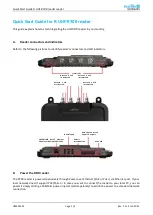
Chapter 4
Theory of Operation
4-2
©
National Instruments Corporation
Interrupt Control Circuitry
Interrupt control circuitry enables and disables interrupts. Two
software-controlled registers determine which devices, if any, generate
interrupts in the interrupt circuitry of the DAQPad-6507/6508 devices.
Each of the four 82C55A devices has two interrupt lines, PC3 and PC0,
connected to the interrupt circuitry.
Each of the eight interrupt lines can interrupt the host computer if the
interrupt circuitry is enabled and the corresponding enable bit is set.
Normally, PC3 and/or PC0 of the 82C55A devices are controlled by the
handshaking circuitry; however, you can configure and use either of these
two lines for input and external interrupts. An interrupt occurs on the
low-to-high transition of the signal line. Refer to Appendix B,
for more information.
USB Microcontroller
The USB controller is a special microcontroller that has circuitry necessary
to transmit and receive data over USB itself. It maintains information about
the status of the bus and follows the USB protocol to acquire and send
information over the bus. The microcontroller receives instruction codes
over USB, parses the instructions, and executes them. NI-DAQ handles all
interaction with the microcontroller.
82C55A Programmable Peripheral Interface
The four 82C55A PPI chips are the heart of the DAQPad-6507/6508
devices. Each of these chips has 24 programmable I/O pins that represent
three 8-bit ports: PA, PB, and PC. Each port can be programmed as an input
or an output port. The 82C55A has three modes of operation: simple I/O
(mode 0), strobed I/O (mode 1), and bidirectional I/O (mode 2). In modes
1 and 2, the three ports are divided into two groups: group A and group B.
Each group has eight data bits and four control and status bits from port C
(PC). Modes 1 and 2 use handshaking signals from port C to synchronize
data transfers. Refer to Appendix B,
, for more
detailed information.
















































